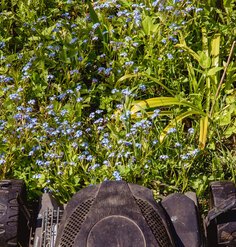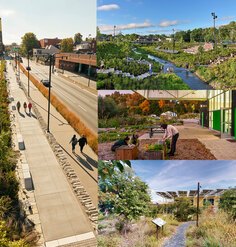From the Field: Ecological Succession and Plant Choice
By Wes Griffith, BSLA Student, and Chris Sass, Assistant Professor, University of Kentucky
While participating in LAF’s 2015 Case Study Investigation (CSI) program, many themes came to the surface, but one stood out to us as an area directly addressable by landscape architects. That theme is the issue of ecological succession and plant choice. Ecological succession describes how ecosystems change over time, sometimes in a predictable manner, but not always. So how do we as landscape architects begin to address ecological succession through our sustainable designs and planting plans?
One of the first goals to help landscape architects think about ecological succession should be to set a long-term management plan that dictates how a landscape will be managed, including removal of invasive plants, the addition of native seed or plants, and the social dynamic of the site. Such goals were addressed in one of the projects we studied, the Lower Howard’s Creek Corridor Management Plan, which considers ecological, social and economic integrity.
A long-term management plan is necessary because succession occurs over a long time period. How long is long-term? Well, for example, the second growth forest at Lower Howard’s Creek has been re-establishing since the late 1800s and we are just now starting to see some mid-successional species as early successional species are beginning to be replaced. Species such as Eastern Red Cedar (Juniperus virginiana), Honey Locust (Gleditsia triacanthos) and foxtail (Seteria spp) are being replaced by oaks (Quercus spp), Shagbark Hickory (Carya ovata) and Riparian Wild Rye (Elymus riparius). So how long is long-term? Definitely longer than our current 25-year project lifespan. This reminds me of the Iroquois maxim stating we need to plan for the seventh generation if we are to truly achieve sustainability.
The Coefficient of Conservatism (CoC) is a tool we can use to plan for ecological succession. CoC numbers range from 1 to 10, where lower numbers indicate a wider range of plant tolerance and higher numbers indicate a much lower range of tolerance. The later successional species mentioned above exhibit a higher CoC number, meaning they require a more specific habitat and exhibit a lower tolerance range. While it may seem like the right thing to do, using higher CoC plants in our initial planting plans is probably not the best idea. Unless we are certain — or make certain through costly amendments — that the specific habitat requirements are there, the higher CoC plants will not make it very long, and we will have wasted the plants and the opportunity. We see this mistake often in our profession. For example, a planting plan may call for Shooting Star (Dodecatheon meadia), which in many areas is endangered or threatened and has a high CoC. It is tempting to plant, but will this plant not only survive but thrive and reproduce in a new planting area? Probably not unless the habitat is within its tolerance range.
Using the CoC, we can plan plantings by assessing the stage of succession we are designing. Higher CoC numbers will require very specific tolerance ranges and habitat types, while lower CoC numbers will be much less fussy in the landscape. Looking through some of the project planting schedules for the sites we studied, we noticed that the CoC values of plant species ranged from 1 to 10, the minimum and maximum numbers. The question becomes: What have we designed for? A highly established landscape that is fairly stable? Or one that is just beginning to establish itself at the early seral stages?
Maintenance plays an important role in how we begin to plan for successional landscape designs. We have found maintenance to be an issue at two of the sites we studied. Both college campus projects, Northern Kentucky University’s Norse Commons and the University of Kentucky’s College of Agriculture Alumni Plaza, used native plants, and unfortunately, some of the planted species have been outcompeted.
In all, as a profession concerned with sustainable approaches, we should think beyond the 25-year mark and aim more for the century mark and beyond. Let’s be more like the Iroquois and plan for seven generations.
Research Assistant Wes Griffith and Research Fellow Chris Sass are participating in LAF’s 2015 Case Study Investigation (CSI) program and working to evaluate the environmental, economic and social performance of three sustainable landscape projects in Kentucky. Any opinions expressed in this article belong solely to the author. Their inclusion in this article does not reflect endorsement by LAF.











